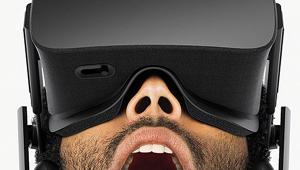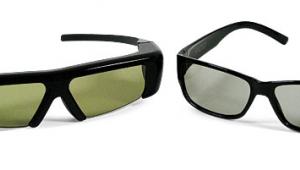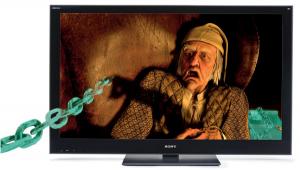I am with Card on the aesthetics of 3D. Not so on the biology/evolution of sight.As to depth of field...while you can manipulate the depth of field with a lens, the greater the depth the more options your eye/brain can select from on which to focus. No matter the lens your eyes/brain still capture in the the same way. You just have a broader field to scan. That being said, the shorter the depth of field of the lens can, in effect, force you to see with a more limited field of vision. I do not think 3D will go away but it needs to get much better to transcend gimmick and somehat of a distraction.
Orson Scott Card on 3D

His main beef with Alice is that Burton tried to update a classic tale in a vain attempt to improve upon Lewis Carroll, which failed miserably in his view. I couldn't disagree more. I thought the basic story concept of Alice was brilliant, and the 3D—which was applied in post-production, not during shooting—looked quite good in the Imax presentation I saw. (Tom didn't see it in Imax and thought it looked pretty poor, but shortly after that, he and I saw clips on a Samsung 3DTV, and he said it was far better than he remembered in the commercial theater.)
Card's thoughts on 3D in general are equally unequivocal. He says that, even though many of the technical problems have been solved, 3D is "the most worthless film technology ever developed, with the possible exception of smell-a-vision."
Card says that the "gimmick of 3D" is based on binocularity—that is, seeing the world through two eyes spaced a certain distance apart—which is entirely correct. But he goes on to say that, in terms of evolution, the purpose of having two eyes is not binocularity, but redundancy, so that if you lose an eye, you can still see. According to Card, we gauge distance primarily via focus, and binocularity is simply a byproduct of the fact that two eyes cannot occupy the same space.
I don't buy that. Focus is no doubt important in gauging distance, but it's far more difficult to do so accurately without binocular vision. Also, consider predator and prey animals—most predators' eyes face forward so they can accurately gauge the distance to their next meal, while most prey animals' eyes are on the sides of their head so they can see predators coming from just about any direction. So two eyes are clearly more important than simply having a spare.
Speaking of focus, Card rightly points out that, while each of us can independently focus on anything at any distance in the real world, the focus in a movie is fixed for all viewers. Also, whereas far-away objects look blurry when we focus on nearby items in the real world and vice versa, everything is in focus in a 3D movie no matter where an object is located, which is completely counter to our normal experience and thus renders 3D movies less realistic.
He might have a point here, especially when it comes to animated movies, which comprise the majority of recent 3D titles. If everything is always completely in focus at any distance, that is indeed unnatural and could contribute to the sense of unease that some people feel when watching such a 3D movie.
However, Card loses me when he says, "The old-fashioned 2D movie is much, much closer the way we see the real world, because the lens focuses the way our eyes do—when one thing is in focus, farther and nearer things are less in-focus." This is not necessarily true, because it depends entirely on the camera's depth of field, which can be increased or decreased at will, something the human eye cannot do. This is equally true for live-action 3D shots, so his argument doesn't hold up in this case.
Card calls 3D "a medium so unreal that we will never really forget ourselves and fall into the audience-trance that makes storytelling arts an essential part of human life. 3D makes you watch the film instead of forgetting the film and watching the people." My own experience belies this—I certainly fell into the "audience-trance" as I watched Alice. However, I didn't when watching Avatar, but that was because I was unconvinced by the story and characters, not because it was 3D. Even so, I did forget I was watching a 3D movie at some points.
He ends with a sentiment shared by many: "And even when they don't give me a headache, I hate the glasses. When am I ever going to lean back in my chair at home, ready to watch a film on DVD, and be glad to put on a special pair of glasses? I don't think 'never' is too strong a word." I doubt I'll ever want to watch everything in 3D, but "never" is, in fact, too strong a word for me.
- Log in or register to post comments

I'm not buying the "gimmick" line - while it's been rightly used to describe things like smell-o-vision and electrified chairs, it was also used to describe Talkies and color when they first appeared. And I do think they're appropriate comparisons to make; like color and sound did, 3D makes a movie more like our natural experiences. I'm sure we all agree that "more like our natural experiences" isn't at all necessary to make a film good, but I don't think we can just dismiss it either. I'd say that, like color, 3D is something best left out of movies that weren't filmed in a way that captures it properly. When we're complaining about 3D added in post-processing being a gimmick, I think it's very valid. I'd make the same argument with colorization! The "if the movie is good this isn't needed" argument is a fine one, of course... just watch Metropolis and you'll be reminded of how little is needed to make a well-written movi

(Sorry, got cut off) The "if the movie is good this isn't needed" argument is a fine one, of course... just watch Metropolis and you'll be reminded of how little is needed to make a well-written movie work. But this doesn't mean color and sound haven't been worthy additions! The only problem I see is the glasses - I think 3D is the way of the future, and even I hate the things. When we have 3D without them, and directors are filming with 3D cameras to add depth rather than to throw things at the audience, I think we'll start to recognize 3D as more than just a gimmick.

The biggest problem with 3D for me is the gimmicky way in which it is used in movies. I haven't seen Alice in Wonderland, but the reason the 3D worked for me in Avatar is that, for the most part, the effect was used subtly to draw the user into the scene. Rarely was something "flying out of the screen." Ironically, the 3D movies where stuff flies out of the screen are the ones that tend to remove me from the movie. After such an effect, it's natural to sit back and say to yourself "that was amazing because it was fake but I jumped as if it were real!" In other words, you're thinking about how what is happening on the screen is not real.

Card is also wrong about everything being in focus on a 3D movie. I didn't waste my time with Burton's "Alice", so maybe that's how it is in that film. Most 3D films, however, accurately display TWO common elements of binocular vision: Focus, and convergence. What's in focus in any particular shot of any particular film is entirely the choice of the cinematographer, whether in 2D or 3D. "Up" and "Avatar" both use short depth of field effectively, and the 3D versions convey the focus depth very well(the first shot in "Avatar"--an extreme close-up of Worthington's face--took my breath away). The more problematic issue for me is convergence. When our binocular vision picks an object to look at, our eyes converge on that point and we see just one image. But when we are so close to an object that we can't see all of it with one eye, or so close we can't focus on it, we see double. Additionally, everything in our field of vision that our eye

....can't focus on is seen as double. It's just that our brain is good at filtering that out. But the brain doesn't filter it out on the movie screen. That's why in 3D movies, anything passing quickly through the shot at a very close distance appears in double. This especially happens with small objects like birds or plants. When objects are that close to the screen, the brain can't process the double images correctly and the viewer ends up seeing double images. This happens a lot with movies like "Up" and "Cloudy With a Chance of Meatballs". It's very distracting and immediately takes me out of the film.

Re: Mr. Card's opinion that 3D is not worthwhile, I think more time must pass. To movie makers, 3D is a new toy and they seemingly cannot help themselves from using it. As a result, the decision-making process at movie studios right now appears to be "I want to do all of these 3D effects shots I have imagined, let's write a script that justifies the shots." Instead, the thinking should be "I have a really good story for a movie, would the story or the story-telling be enhanced by incorporating 3D?" I don't think the value of 3D can be determined until movie makers start asking the second question, and the novelty of 3D has to wear off before that can happen.

I saw Avatar on 3D twice and Alice on IMAX 3D. The images were dark and blurry (especially Alice, which was absolutely unwatchable). I tried it, I hated it, I'm not watching any more 3D. It's gimmicky, unpleasant, and totally detracts from the movie. As far as putting on glasses to watch something at home, I wouldn't do that if you could guarantee me bright, 100% immersive 3D images. I'm also not going to sit in a feedback chair, put a helmet on my head and pretend that I'm in video game. People who do that need to wake up and discover real life.

He has one key element correct. The use of animation and graphics AS stars instead of stories and characters is getting way out of hand. Avatar is one of the worst movies I've ever seen. I would have like it when I was 8. This Alice was horrible. Again, completely dumbed down and a vapid waste of time. The graphics were the only enjoyable part of the movie and they wore thin rapidly. 3d can't save bad movies.
























































